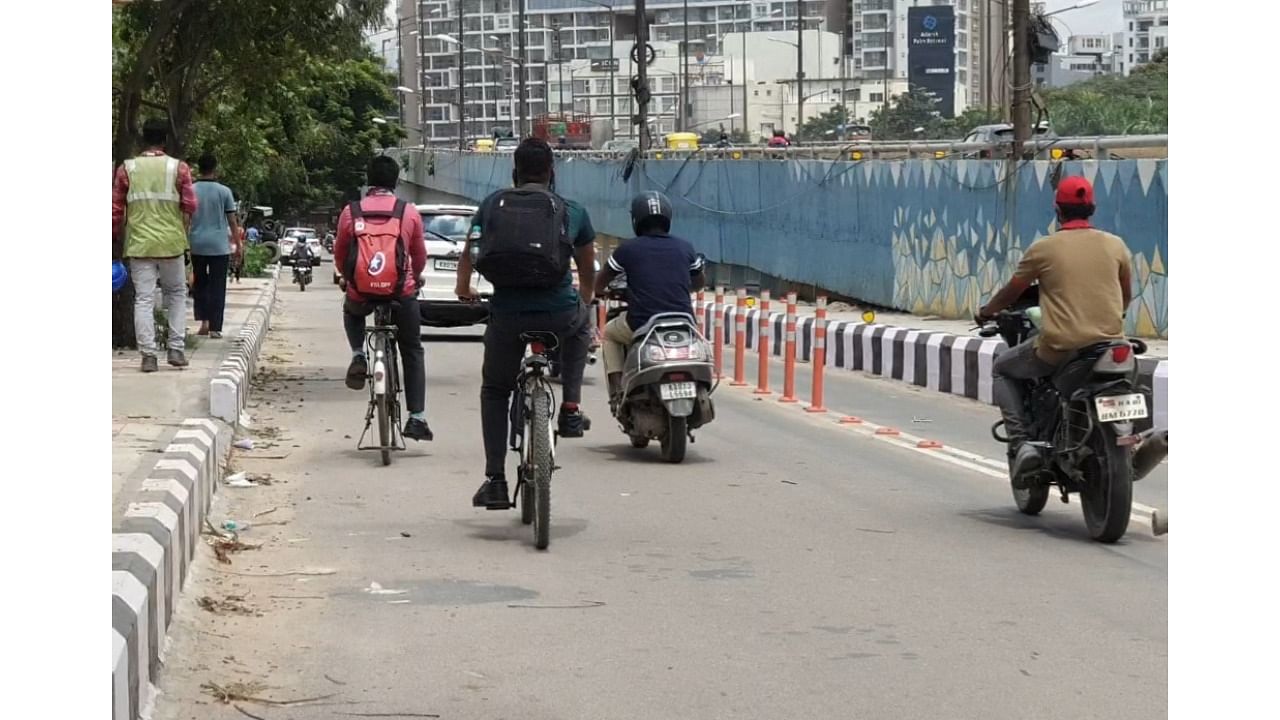
Unmarked, disjointed and encroached upon by men on motorbikes, the cycling lanes along the city's Outer Ring Road (ORR) are not exactly a model for safe, sustainable transport. Beyond the popup barricades, the lane has nothing to show it is meant exclusively for cyclists, and that is a problem not going away in a hurry.
Hype is never in short supply when a cycling lane is launched anywhere in Bengaluru. A reality check by DH of the ORR stretch showed just why it all sounds so hollow. Barricaded on the extreme right of the service road, the lane starts well from Agara Junction only to disappear without a trace in stretches all along the ORR.
'Cyclists Only' signage, mandated by the Directorate of Urban Land Transport (DULT), are rarely seen. Stencilled cycling marks on the lane, a global standard, are missing. Inevitably, motorcyclists invade this space, speeding and scaring away the odd cyclist who dares to ride on a lane meant exclusively for him/her.
No signboards either
"It is very important to constantly remind the motorists that the barricaded lane is only for cyclists. This needs to be reinforced through signboards every 50 or 100 metres. They should also use oxide-based colouring on the demarcated lane with stencilling instead of paint, which peels off," says Bengaluru's Bicycle Mayor Sathya Sankaran.
The DULT had given clear guidelines on how this should be done. But the Bruhath Bengaluru Mahanagara Palike (BBMP) contractors who put up the lane stopped with the barricade. Near the Agara Junction, the lane was even used as a storage space for pavement tiles before a social media outcry by cyclists forced a clearance.
Cycling groups on weekend rides on the ORR stretch could collectively direct motorcyclists away from the lane. But, as Sankaran points out, they too are handicapped by the lack of clear signage. "We often don’t have an answer when the motorcyclists ask for proof," he notes.
Contract labourers often rely on their cycles to commute between their home and workplace in the multiple IT units situated along the ORR. They ironically avoid the cycling lanes completely for a reason: Safety. "It is not safe. Vehicle users approach us at great speed and there is not enough space to move away," explains Ravi Kumar, a contract worker near Bellandur.
Indiscipline
But even if the lanes are demarcated with signage, there is the question of addressing the embedded traffic indiscipline in motorists. Contends Dheeraj Subramanian, an active cyclist who organises regular cycling treks outside the city, "Pop-up lanes don't work because vehicle users don't care. They don’t even respect the medians if there is no cop around. It is a question of discipline."
This lack of respect for cyclists and the safety question has made Subramanian take a conscious decision never to ride within the city. This is unlikely to change soon as the cycling lanes that have come up in the city centre are disjointed without a network.
Besides, as Sathya points out, there is no continuity across traffic intersections. "The lanes come to a dead-end at the junctions. There are no ramps to get off the lane, as seen on Race Course Road. Moreover, you need lanes on both sides. The 1.5-metre width is too narrow for a bi-directional lane."
At many stretches left without barricades, the lanes morph into car parking spaces. Years ago, a cycling lane experiment had failed precisely for this reason in Jayanagar. The ORR and inner city lanes of today will meet the same fate if the original plan is poorly executed and enforcement is lax, warn sustainable mobility experts.
Check out latest DH videos here